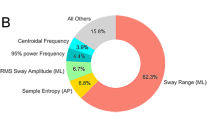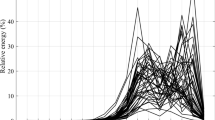Abstract
A cross-sectional study of postural sway analysis in older non-fallers, once-fallers and multiple-fallers using five common standing tests was conducted. Eighty-six older subjects with an average age of 80.4 years (SD ± 7.9) participated in the study. The angular rotation and velocity of the trunk of the participants in the roll (lateral) and pitch (sagittal) planes were recorded using an inertial sensor mounted on their lower backs. The Gaussian Mixture Models (GMM), Expectation-Maximisation (EM) and the Minimum Message Length (MML) algorithms were applied to the acquired data to obtain an index indicative of the body sway. The standing with feet together and standing with one foot in front, sway index distinguished older fallers from non-fallers with specificity of 75.7% and 77.7%, respectively, and sensitivity of 78.6% and 82.1%, respectively. This compares favourably with the Berg Balance Scales (BBS) with specificity of 70.5% and sensitivity of 75.3%. The results suggest that the proposed method has potential as a protocol to diagnose balance disorder in older people.

Graphical abstract








Similar content being viewed by others

References
Nashner LM, Woollacott M (1979) The organization of rapid postural adjustments of standing humans: an experimental-conceptual model. Posture Movement 243:257
Davidson M, Madigan ML, Nussabaum MA (2004) Effects of lumbar extensor fatigue and fatigue rate on postural sway. Eur J Appl Physiol 93(1–2):183–189
Fernie GR, Gryfe CI, Holliday PJ, Llewellyn A (1982) The relationship of postural sway in standing to the incidence of falls in geriatric subjects. Age Ageing 11(1):11–16
Melzer I, Benjuya N, Kaplanski J (2004) Postural stability in the older: a comparison between fallers and non-fallers. Age Ageing 33(6):602–607
Laughtona CA, Slavinb M, Katdarea K, Nolana L (2003) Aging, muscle activity, and balance control: physiologic changes associated with balance impairment. Gait and Posture 18(2):101–108
Maki B, Holliday P, Topper AK (1994) A prospective study of postural balance and risk of falling in an ambulatory and independent older population. J Gerontology: Medical Sci 49(2):72–84
Black FO, Wall C, Rockette HE, Kitch R (1982) Normal subject postural sway during the Romberg test. Am J Otol 3(5):309–318
Goldie PA, Back TM, Evans OM (1989) Force platform measures for evaluating postural control: reliability and validity. Archive Physical Medicine Rehabilitation 70(7):510–517
Swanenburg J, de Bruin ED, Uebelhart D, Mulder T (2009) Falls prediction in older people: a 1-year prospective study. Gait & Posture 31(3):317–321
Ladislao L, Fioretti S (2007) Nonlinear analysis of posturographic data. Medical Biological Engineering Computing 45(7):679–688
Rocchi L, Chiari L, Cappello A (2004) Feature selection of stabilometric parameters based on principal component analysis. Medical Biological Engineering Computing 42(1):71–79
Howcroft J, Kofman J, Lemaire ED (2013) Review of fall risk assessment in geriatric populations using inertial sensors. J Neuroengineering Rehabilitation 10(1):91
Taraldsen K, Chastin SF, Riphagen II, Vereijken B, Helbostad JL (2012) Physical activity monitoring by use of accelerometer-based body-worn sensors in older adults: a systematic literature review of current knowledge and application. Maturitas 71(1):13–19
Shany T, Redmond SJ, Marschollek M, Lovell NH (2012) Assessing fall risk using wearable sensors: a practical discussion Bestimmung des Sturzrisikos mit tragbaren Sensoren: eine praxisnahe Diskussion. Z Gerontol Geriatr 45(8):694–706
Gill J, Allum JH, Carpenter MG, Held-Ziolkowska M, Adkin AL, Honegger F, Pierchala K (2001) Trunk sway measures of postural stability during clinical balance tests: effects of age. J Gerontology: Medical Sci 56(7):M438–M447
Berg K, Norman K (1993) Functional assessment of balance and gait. Gait Balance Disorders 12(4):705–723
Zaiane OR (1999) Principles of knowledge discovery in databases, Department of Computing Science, University of Alberta , 1999
Silvestre C, Cardoso MGMS, Figueiredoc MA (2014) Identifying the number of clusters in discrete arXiv preprint arXiv 1409.7419
Douglas R (2015) Gaussian mixture models. In Encyclopedia of biometrics, Springer, Lexington, pp 659–663
Wallace CS, Boulton DM (1968) An information measure for classification. Comput J 11(2):185–194
Cheeseman P, Stutz J (1996) Bayesian classication (autoclass): theory and results. In: Advances in knowledge discovery and data mining. AAAI press, Menlo Park, pp 153–180
Melzer I, Kurz I, Oddsson LI (2010) A retrospective analysis of balance control parameters in older fallers and non-fallers. Clin Biomech 25(10):984–988
Aramaki Y, Nozaki D, Masani K, Sato T, Nakazawa K, Yano H (2001) Reciprocal angular acceleration of ankle and hip joints during quiet standing in humans. Exp Brain Res 136(4):463–473
Aminian K, Najafi B (2004) Capturing human motion using body-fixed sensors: outdoor measurement and clinical applications. Computer Animation Virtual Worlds 15(2):74–79
Close J, Ellis M, Hooper R, Glucksman E, Jackson S, Swift C (1999) Prevention of falls in the older trial (PROFET): a randomised controlled trial. Lance 353(9147):93–97
Brocklehurst JC, Robertson D, James-Groom PA (1982) Clinical correlates of sway in old age: sensory modalities. Age Ageing 11(1):1–10
Potvin AR, Syndulko K, Tourtellotte WW (1980) Human neurologic function and the aging process. J Am Geriatr Soc 28(1):1–9
Scheffer AC, Schuurmans MJ, Van Dijk N, Van Der Hooft T, De Rooij SE (2007) Fear of falling: measurement strategy, prevalence, risk factors and consequences among older persons. Age and Aging 37(1):19–24
Era P, Heikkinen E (1985) Postural sway during standing and unexpected disturbance of balance in random samples of men of different ages. J Gerontol 40(3):287–295
O’Sullivan M, Blake C, Cunningham C, Boyle G, Finucane C (2009) Correlation of accelerometry with clinical balance tests in older fallers and non-fallers. Age Ageing 38(3):308–313
Greene BR, McGrath D, Walsh L, Doheny EP, McKeown D, Garattini C, Cunningham C, Crosby L, Caulfield B, Kenny RA (2012) Quantitative falls risk estimation through multi-sensor assessment of standing balance. Physiol Meas 33(12):2049–2063
Giansanti D, Maccioni G, Cesinaro S, Benvenuti F, Macellari V (2008) Assessment of fall-risk by means of a neural network based on parameters assessed by a wearable device during posturography. Med Eng Phys 30(3):367–372
Giansanti D (2006) Investigation of fall-risk using a wearable device with accelerometers and rate gyroscopes. Physiol Meas 27(11):1081–1090
Acknowledgements
The authors thank Melissa Roach, the clinical physiotherapist, for her supervision during the experimental tests. Miss Maryam Ghahramani, the chief investigator, did this study as a part of her PhD. thesis. Her PhD scholarship was funded by Illawarra Shoalhaven Local Health District (ISLHD). The authors wish to acknowledge that Bulli Hospital, Bulli, Australia, and Wollongong Hospital, Wollongong, Australia, provided this study with older participants.
Author information
Authors and Affiliations
Corresponding author
Ethics declarations
The participants were asked to read and sign an informed consent statement. The ethics committee of the University of Wollongong, Wollongong, Australia (HE13/125), approved this study.
Rights and permissions
About this article
Cite this article
Ghahramani, M., Stirling, D., Naghdy, F. et al. Body postural sway analysis in older people with different fall histories. Med Biol Eng Comput 57, 533–542 (2019). https://doi.org/10.1007/s11517-018-1901-5
Received:
Accepted:
Published:
Issue Date:
DOI: https://doi.org/10.1007/s11517-018-1901-5



